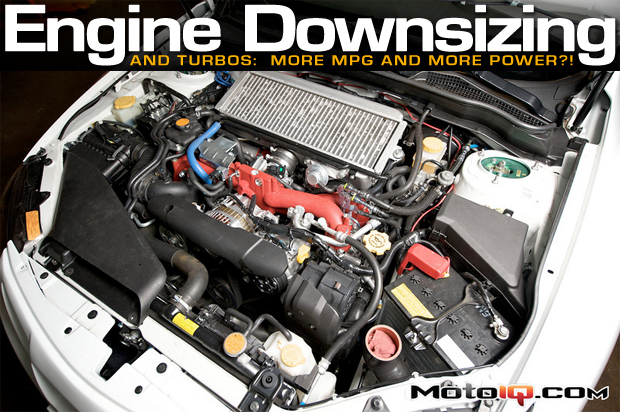 |
Engine Downsizing and Turbos: More MPG and More Power?!
By Khiem Dinh
Khiem Dinh is an engineer for Honeywell Turbo Technologies at the time of this writing. All statements and opinions expressed by Khiem Dinh are solely those of Khiem Dinh and not reflective of Honeywell Turbo Technologies.
In an extremely rare instance, government regulations have actually made two seemingly conflicting goals both better. “To have one’s cake and eat it too” as they would say. With rising fuel costs and environmental concerns, regulatory bodies across the world are demanding reduced fuel consumption and lower emissions. Previously, this would imply smaller engines with reduced horsepower; two things counter to the wants of performance enthusiasts. Enter the modern turbocharged engine. Through turbocharging, engines can now deliver a wider torque curve, more power, and substantially improved fuel economy. The trend has even reached up as far as Ferrari now with the 488 having a boosted downsized engine relative to the 458. Additionally, the new base Porsche 911 Carrera has downsized from 3.4/3.8L naturally aspirated engines to 3.0L turbo engines. The fuel economy gains are through engine downsizing and downspeeding. We’re going to show you how turbos achieve all of these goals.
First, we need to look at naturally aspirated engines. The torque curve of a naturally aspirated engine is greatly influenced by the volumetric efficiency (VE) of the engine. There are many factors affecting VE: intake and exhaust manifold lengths, cam profiles, cam timing, intake and exhaust port lengths and geometries, number of valves, bore vs. stroke, rod ratio, etc. Generally, all of these variables can be optimized to provide the best VE, and therefore torque, in a narrow rpm range. This also means that VE and torque are sacrificed in other portions of the rpm range. Old school V8 hot-rodders are well aware of this fact when they swap in a big cam; they end up with the lopey idle and weak bottom-end torque to gain the top-end torque and horsepower. In effect, they reduced the VE in the lower rpm range for better VE in the upper rpm range. Modern engines have continually employed new technologies to minimize these trade-offs in the pursuit of better VE and torque across the rpm range.
The technologies probably having the greatest impact in improved VE and torque in the greatest range are related to the valves and cams of the engine. The factors related to valves affecting VE include lift, duration, overlap, and timing. In order to have optimal VE across the rpm range, the factors have to be adjustable. One of the first mass produced systems to address this was Honda’s VTEC system which essentially had two cams in one; one set of cam lobes were optimized for lower rpm operation while the other set of cam lobes were designed to maximize VE in the upper rpm range. Since that time, many new systems are now in production enabling variable valve lift, duration, and timing allowing engineers to extract the best torque from of an engine across all rpm ranges. A few of these systems are the BMW VANOS (Variable NOckenwellenSteuerung which is German of course), Nissan VVEL (Variable Valve Event and Lift), and Mitsubishi MIVEC (Mitsubishi Innovative Valve timing Electronic Control). The newest kid on the block that I am aware of is the Fiat Multi-Air system which has so much adjustability that it can actually open and close the intake valve twice during the intake stroke.
 |
| The Evo X uses Mitsubishi’s MIVEC adjustable cam timing system to achieve a fat powerband. |
 |
| Nissan’s VQ37 features the VVEL system to get the most out of the naturally aspirated engine. |
The holy grail of all torque curves is the flat torque curve and all of these valve systems aim to achieve the table top shape. However, as much as they try, they are still limited by the physics of cams, valves, lifters, rockers, and every other part in the valvetrain which prevents them from getting the same VE across the entire engine speed range. Therefore, the torque curve is not flat.
 |
| Here is a chart showing the VE curve for an Acura NSX and also how VTEC affects the curve. Firstly, the curves are not even close to flat. The second observation shows how having two optimized cams profiles (the two cam profiles used in the VTEC system) improved the VE across the entire engine speed range due to having to make fewer compromises on cam profile. |



